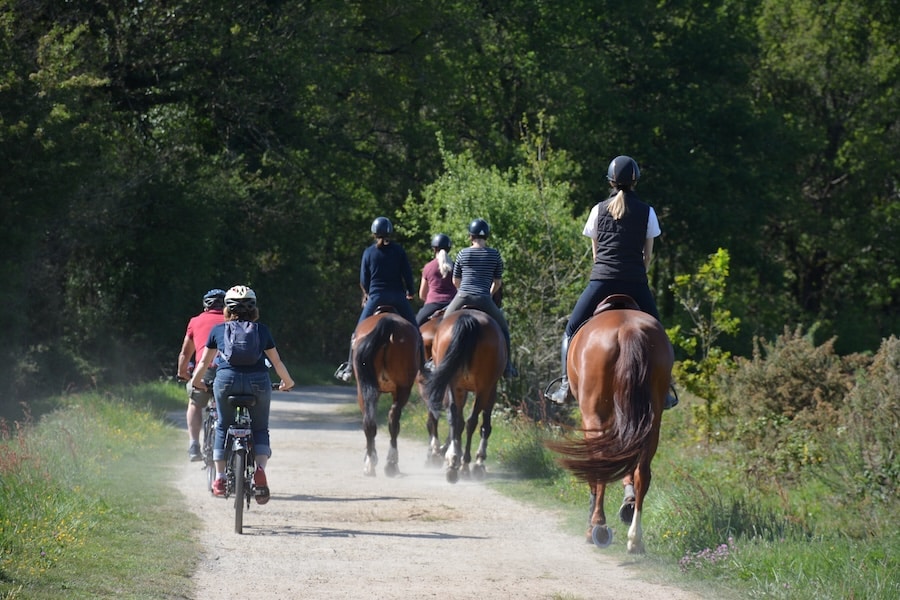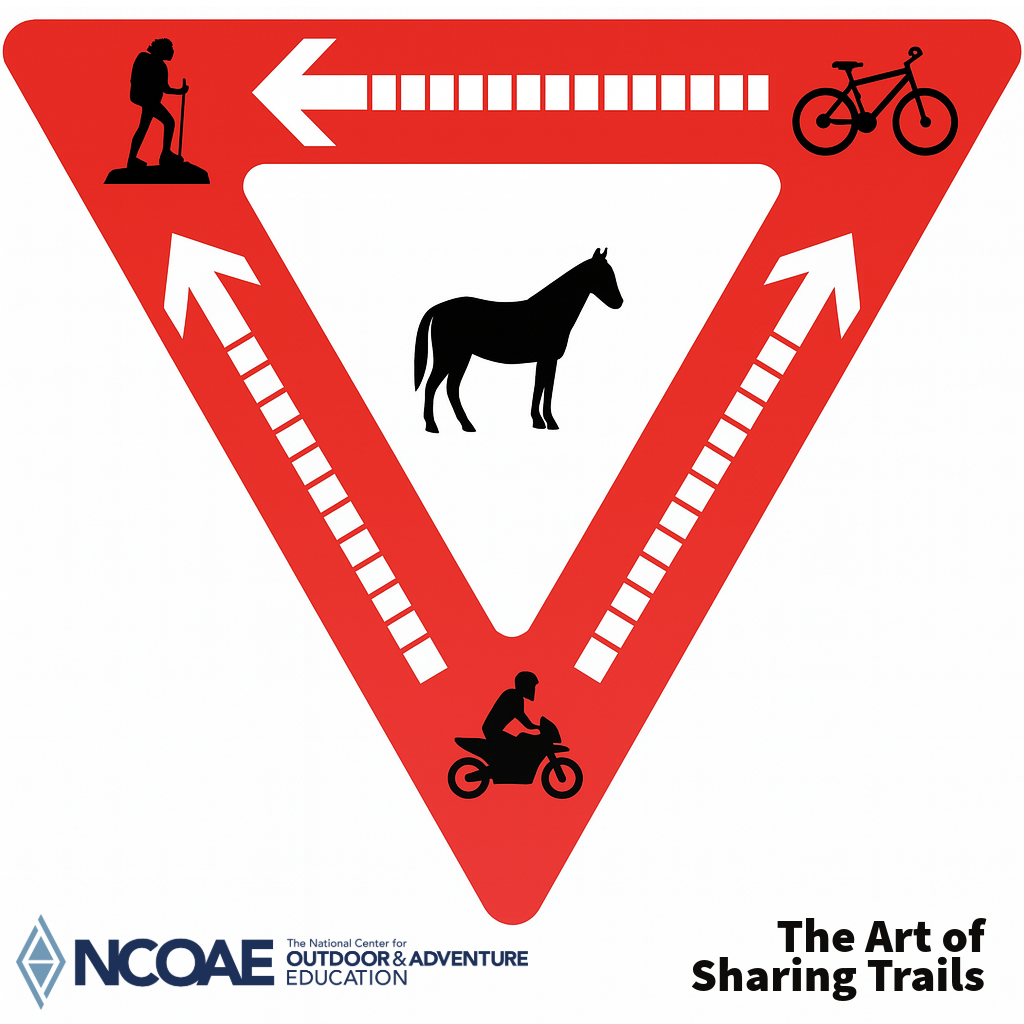There it is, middle fingers up, people screaming at one another, animals running amok. It’s just another day on the trails lost to behaviors that are normally reserved for Los Angeles traffic.
It doesn’t need to be this way.
So long as everyone’s aware of the rules and then follows them, hikers, bicyclists, horses, and dogs can share the trails in peaceful harmony.

All of us should have access, as well as the right, to enjoy trails designated as multi-purpose. Open access is great. And, of course, the more access we provide to people who engage in diverse outdoor activities, the more money is available to maintain and expand trails, and the more voices we have to ensure that trails remain intact.
Yes, access for many is great for everyone until it isn’t. I have witnessed abominable behaviors — physical fights, trash talking, and worse — in my time on trails. More often than not, one or all of the guilty parties were at fault, usually because they weren’t cautious, didn’t know or practice proper trail etiquette, or lacked the skills to behave with a modicum of courtesy and civility.
In this post, I bring you up to speed on the rules and best practices that can make everyone’s time on trails more enjoyable.
Follow the Sign
Whenever you’re out on a trail, you’re wise to follow the signs, and I’m not just talking about trail markers. Here’s a sign that serves as a great visual for remembering who yields to whom on multi-use trails.

Here’s what it means:
- Bicyclists yield to hikers.
- Motor vehicles yield to hikers and bicyclists.
- Everyone yields to horses.
Easy. Right?
Among the things that make sharing trails and right of ways on trails difficult is that everyone on the trails is in motion. Hikers are moving at around three miles an hour. Cyclists commonly travel at speeds ranging from 10 to 30 miles an hour. Those on e-bikes are often hustling along in excess of 40 miles an hour. And horses typically walk, trot, or canter at speeds ranging from four to 15 miles an hour. These differences in speeds can lead to potentially dangerous encounters, which, in turn, can trigger fear or frustration. Either of those emotions can quickly turn to anger.
Many trail users think of trails as being built specifically and exclusively for their activity, which only compounds the problem. A hiker may think that horses, bicycles, and motorized vehicles have no business on a “hiking trail,” even when the trail is clearly designated as multi-use.
Communication Is Key
The bottom line to keeping everyone happy, safe, and enthusiastic about sharing trails is communication. We all need to do a good job communicating, teaching, and talking to each other.
Here’s an experience I once had on what is technically a mountain bike trail in Western North Carolina. Called the Ridgeline trail in Dupont State Park, it is a fast and flowy route with many switchbacks and their accompanying blind corners.
- Going as fast as possible is my personal goal on this trail. On this ride, as I was coming down through the last set of hairpin turns, I looked up to see a horse and rider climbing the trail. A horse was the last thing I ever expected to see on this trail, and I definitely never expected to encounter a horse ascending a trail that is known for riding downhill.
- I stopped, dismounted my bike and stepped to the side of the trail. After all, everyone yields to horses. Admittedly, I was a little rattled. I had been going superfast, and although I was in control, I was afraid I was going to hit the horse and its rider.
- I asked the rider if he needed me to step further off the trail. He told me I didn’t even need to get off the bike because his horse is used to cyclists. I told him I was following mountain biking (MTB) and horse protocol. The rider thanked me for being considerate of his and his horse’s safety, and they continued their ascent.
- I was a little disappointed I did not get to finish the last turns at full speed, but I was very happy I did not hit a horse and its rider at full speed. I hoped the horse and rider had the same type of interactions with other cyclists on the trail.
Looking back, I’m certain I did everything I was supposed to do, following everything I knew about being around horses on a bicycle. And while I was surprised the rider didn’t care whether I dismounted or not, I remembered my training and climbed off my bike.
I’m certain that positive communication is what made my interaction with the horseback rider turn out well. If I had yelled at him, or he had yelled at me, the outcome and our experiences would been drastically different, and not in a good way. Quality communication will always help when interacting with multi-use trail enthusiasts.
I could share more examples, experiences, and suggestions, but the best way to build your knowledge and understanding of trail etiquette is to check out reliable information from trusted organizations. These include the National Park Service’s Hike Smart and USA Cycling’s Trail Etiquette for Mountain Bikers.
I really like the Tread Lightly courses that provide information on trail usage. That’s because I think Tread Lightly has lots of solid information on multi-trail use, ethics, and protocol. I took some Tread Lightly courses as part of my research on this topic and got a lot out of it. Tread Lightly also has good child and young adult resources as well as printable materials and certificates for course completion. For more information, visit treadlightly.org and be sure to check out the T.R.E.A.D. principles at treadlightly.org/learn:
Travel responsibly
Respect the rights of others
Educate yourself
Avoid sensitive areas
Do your part
The Seven Essential Guidelines for Safe and Courteous Trail Use
As I wrap this post up, it’s important to know that there are seven guidelines that you should be aware of for using and sharing multi-use trails. I do my best to follow these myself, and encourage you to do the same.
1. Stay right, pass left.
- Generally, trail users should stay to the right side of the trail.
- When passing, do so on the left side and announce your presence.
- Faster users should yield to slower or oncoming traffic.
2. Announce your presence.
- Use audible signals (bell, voice, horn) to alert others of your presence, especially when approaching or passing.
- If encountering horseback riders, say “hello” to alert them of your presence.
- When passing, loudly say, “PASSING ON YOUR LEFT.”
3. Wheels yield to heels.
- Motorized vehicles and cyclists generally yield to hikers, walkers, and horseback riders.
- Hikers and walkers should yield to horseback riders, especially if they are on a turf trail.
- Trail users traveling downhill should yield to uphill traffic.
4. Be mindful of your pets.
- Keep dogs on a leash (typically six feet non-retractable) and under control.
- Ensure your dog is not a hazard to other users.
5. Follow local rules and regulations.
- Be aware of any specific rules or regulations for the trail you are using.
- Pay attention to any signs along the trail that may indicate specific directions or restrictions.
6. Practice Leave No Trace principles.
- Properly dispose of trash, including pet waste.
- Avoid disturbing wildlife and keep your distance.
- Leave rocks, vegetation, and artifacts where you find them.
7. Note other important considerations.
- Use safe speeds and be aware of your surroundings.
- If stopping or standing still, move off to the side of the trail to allow other users to pass.
- Be courteous and communicate with other trail users.
Keep in mind that the purpose of guidelines and rules is not to ruin the fun. To the contrary, they ensure that everyone can enjoy the trails safely and free of uncomfortable and potentially dangerous interactions. My advice is simple: know the rules and guidelines, follow them, and always be courteous to others while in the backcountry!
– – – – – – –
About the Author: Stephen Mullaney is the Director of School Partnerships and Staff Development at The National Center for Outdoor & Adventure Education (NCOAE).
TALK TO US
Have any further questions about our courses, what you’ll learn, or what else to expect? Contact us, we’re here to help!
Leave a comment